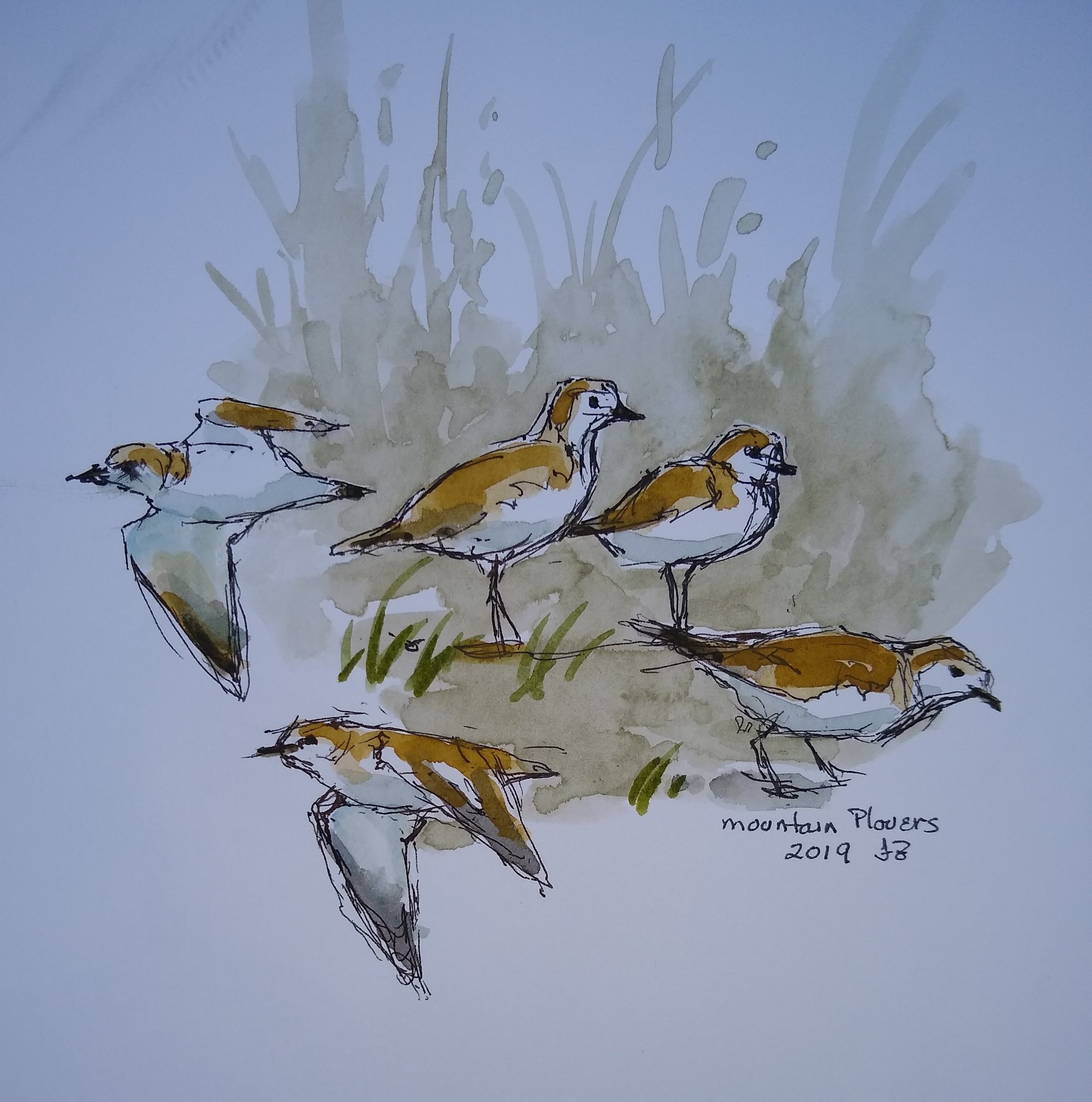Bewick’s Wren’s reside in our year round and I wonder how they feel when the orioles show up in the spring.
‘Spring Visitor to a Wren’s World’ 24” x 18” watercolor
This blog is devoted to showing photographs and paintings of birds, and it is our hope that these images create interest in the enjoyment and the conservation of this diverse group of animals. Your comments are appreciated. If you like a photo or painting, please give it a heart. This helps us understand what our viewers want to see more of.
Bewick’s Wren’s reside in our year round and I wonder how they feel when the orioles show up in the spring.

‘Spring Visitor to a Wren’s World’ 24” x 18” watercolor
This is the third year in a row we have found Green-tailed Towhees among the flowering manzanita shrubs in the Sierras. I love the various greens and the way the orange cap of the towhee mirrors the orange in the manzanita branches.

Towhee and manzanita sketch 2019
A strange looking bird indeed. In the summer this species is common in the Sierra Nevada Mountain Range of California. It prefers relatively dry shrubby mountain slopes. Early in the breeding season they can be located by their unique song.
Last fall, this neighborhood raptor took to hanging out in the pomegranate tree, where he could easily keep track of birds at the feeders.

Cooper’s Hawk and Pomegranates 24” x 12” acrylic

Cedar Waxwing sketch
It was a treat to run across a flock of cedar waxwings last Tuesday especially because it was a slow birding day. This flock was foraging in a flowering madrone tree.
Blue-gray Gnatchater
The Blue-gray Gnatcher is a common bird in Central-Coastal California in the summer. It flits around in the brush wagging and lifting its tail which startles insects causing them to fly to become a tasty morsel for this bird. This photo is of a male because of the blue “V” on its forehead.
If lucky, you will encounter these birds nest building. They gather caterpillar and spider silk and use it to fasten fragments of lichens into a small thimble which becomes the nest. The nest looks like a bump on a tree’s branch and it’s impossible to know if it’s a nest unless you see an adult fly onto it.

Wilson’s Warblers 12” x 6” watercolor on wood panel 2107
Wilson’s Warblers arrive in the summer in California and it is a treat to find the first to appear.

Yellow Warblers and Wild Cherries 12” x 12” watercolor on wood panel
This painting was inspired by yellow warblers feasting on wild cherries here in California in the late summer.

‘Sandhill Cranes and Ibis’, 16” x 16”, watermedia on wood panel
This was a painting I did last year after our trip to the Merced National Wildlife Refuge.

I had to go back five years to find a yellowthroat painting. This is a small study done when I was beginning to experiment painting with watercolor on canvas. I guess it’s time to try another.

It has been raining constantly for the past week and Steven’s Creek, which can be dry in the summer, is overflowing it’s banks. Yesterday we came across a pair of common mergansers in the flooded stream and, while I’ve shied away from painting ducks in the past, these two in the stormy woods spoke to me.
Dave has been posting images of the colorful tanagers we saw in Costa Rica. Our local Central California tanager is the Western Tanager. It is no longer in the Tanager family but the name survives. We see these birds in the summer, particularly in the Sierras, when the males have brilliant breeding plumage. They have inspired many paintings.

In general I don’t like using Dave’s photos as references for my paintings - except when the photo is flawed in some way.. In this case the hawk in the photo was lopped off on the right side. But I loved the pose and used it as reference for this quick sketch. It was amazing to see this hawk up close on our trip through Panoche Valley.

A 12” x 12” watercolor on wood panel
Here is a painting I did a couple of years ago. These are in the same genus (Zonotrichia) as the Rufous-collared that Dave photographed in Costa Rica. They are superabundant in our yard in the winter.

One of the draws of driving to Merced National Wildlife Refuge is to see sandhill cranes. We did not see huge numbers as in past years but several groups were quite close. I love seeing the blue grey birds against dried grasses.

The last three winters we have driven two hours to Panoche Valley to look for Mountain Plovers with no luck. But this year they were there! In fact there was a flock of over 80. In spite of having ‘mountain’ in their name these are birds of short grasslands and were once associated with bison herds.